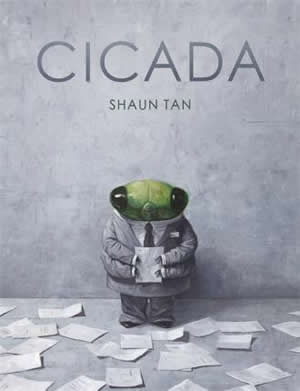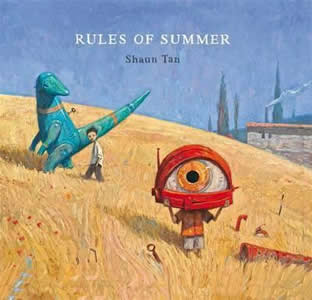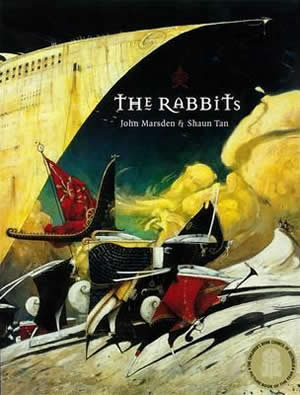Cicada By Shaun Tan, Hachette Australia, 2018. ‘Cicada tell story. Story good. Story simple. Story even human can understand. Tok Tok Tok!’ Cicada is written very differently to other children’s books I’ve read. Its staccato text is reminiscent of people who have English as a second language. Tok Tok Tok! We feel sorry for Cicada as he works hard all day for very little pay and poor conditions. He is bullied by his coworkers. Tok Tok Tok! The repetition of Tok Tok Tok! works well. During the pages where Cicada is tormented by his life and his workplace, the illustrations only appear on the righthand page with the simple text on a white lefthand page. Until Cicada retires from his office job…then we see full-colour double-page spreads with no text, where we watch cicada transform! This is also an unusual approach to a kids picture book. The illustrations by Shaun Tan, as always, are artistic masterpieces. Cicada Book Trailer
Tintinnabula By Margo Lanagan and Rovina Cai, Little Hare, 2017. ‘In wild times and in wartime, in times of fear and illness, I go to Tintinnabula, where soft rains fall.’ The landscape is barren and bleak, with skeletal trees bending to the elements. Rain slices down on the ruins of a building; the chiaroscuro of shadows adding depth to the desolate. A small figure approaches a large opening in the ruins leading to nowhere…or is it? Tintinnabula opens with dark and frightening creatures dominating the small figure of a girl in the bottom corner of the page. They could be inner demons or outer demons. They are very visible though. The illustrations are haunting and emotive and move directionally through the pages. The girl running, tearing, in an effort to be free of the demons on her tail. Always, there is a glimpse of a lighter place, a safer place, but it is far from an immediate reach. And still, the demons come. A feather. A whisp. The faceless character runs through pages following a white bird, until we finally meet her face-to-face, when she arrives in Tintinnabula. The overall colour palette changes from dark and red, to light and…
My Brother By Dee Huxley, Oliver Huxley and Tiffany Huxley, Working Title Press, 2016. ‘When a gentle creature sets out to search for a lost brother, we are taken on an ethereal journey across land and sea to strange, beautiful and faraway places.’ The black and white illustrations are reminiscent of the artist, Escher. They are soft and sensitive, and on the last page, we end with a full-colour illustration of the gentle creature and his brother in a boat together. My Brother is a sad story, but the subject is handled with such care and attempts to present a positive side to a devastating reality. Teacher notes are available. Awards Shortlisted for The Picture Book of the Year 2017 by Children’s Book Council of Australia.
Rules of Summer By Shaun Tan, Lothian Children’s Books, 2000. ‘Never be late for a parade. Never forget the password. Never ruin a perfect plan.’ Um…not sure Shaun Tan… Your illustrations are beautiful as always, but on the first read, I didn’t understand the story. So, I thought I’d run this past a child and get a young person’s view of it. My 12-year-old niece wasn’t too sure about it either. Rules of Summer is not a book I’d personally choose in a hurry. I read somewhere that this is a story of two boys and their adventures, but I didn’t get that from the story on the first read at all. So, I read it again. On my second read of the book I saw the two boys in each picture, but the story? I think the boys have adventures and then they have a fight of some sort, before making up. Rules of Summer offers the reader a long list of rules; things you must never do. Could appeal to children, possibly boys more than girls.
The Rabbits By John Marsden and Shaun Tan, Lothian Children’s Books, 1998. ‘A rich and haunting allegory for all ages, all cultures.’ This book provides a very different perspective on the effect of humans on the environment through a clever metaphorical take on invasion. The Rabbits offers the true story of Australia’s dark history, and uses animals to describe the story. The analogy of rabbits invading the land and causing problems for the original inhabitants softens the reality of the way the situation really was. The Rabbits offers a visual feast of an intriguing, mystical and futuristic land. It is truly an illustrative masterpiece; you’ll feel like you’re in a Daliesque gallery. My 12-year-old niece wasn’t so keen on the illustrations, because she thought they weren’t easy to understand as they imitate life, but are not realistic, so to speak. She thinks it’s maybe more suitable for an older child. She wasn’t aware of the underlying message and needed it explained to her. The Rabbits could provide an opportunity for parents to explain Australia’s dark history to their children in a way that they can understand. Awards Picture Book of the Year, Children’s Book Council of Australia, 1999. Aurealis Conveners’…






